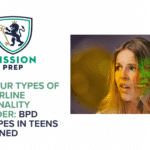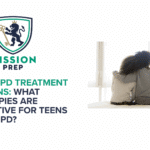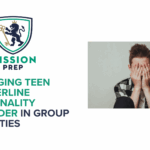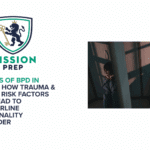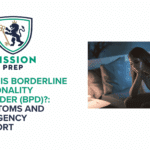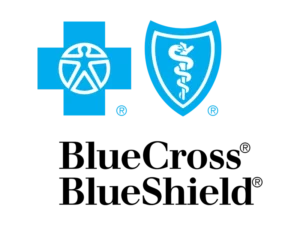Teenage Narcissism Signs: NPD Symptoms in Teens & When to Seek Support

These days, it may feel like every question about physical illness has a quick online answer. Just a few clicks and you can find a checklist of flu symptoms in front of you, complete with tidy explanations.
But explanations for mental health issues rarely work this way, as behaviours don’t always fit neatly into lists. This is especially true with teenagers, for whom eye-rolls, outbursts, and self-focus can blur the lines between normal development and something more serious.
In fact, narcissistic personality disorder (NPD) is one of the hardest mental health conditions to untangle, because so many of its traits overlap with ordinary adolescence.
If you’re concerned about teenage narcissism signs in someone you care about, a mental health professional can provide clarity and guidance. This article may also help you understand NPD symptoms in teens, and whether these are a cause for concern, as it covers:
- Signs of NPD in the DSM-5
- Normal teen behaviour vs NPD traits
- Other conditions that can look like NPD
- How Mission Prep can help

What the DSM-5 Says About NPD
Narcissism is a complex topic, and it can mean very different things depending on whether someone is speaking about it casually or clinically. A useful way to make sense of the signs of narcissism is to look at how professionals define it.
The DSM-5, the manual clinicians use to classify mental health conditions, sets out the diagnostic criteria for narcissistic personality disorder. By looking at these, we can begin to understand the kinds of behaviours that indicate NPD in a person.
To receive a diagnosis, at least five of the following need to be present in a consistent way across different areas of life.1
NPD Symptoms:
- A grandiose sense of self-importance, such as exaggerating achievements or expecting to be recognized as superior without real accomplishments
- Being preoccupied with fantasies of unlimited success, beauty, power, or ideal love
- Believing they are “special” and should only associate with people of similar status or uniqueness
- Requiring excessive admiration
- A sense of entitlement, expecting special treatment or compliance with wishes
- Exploiting others in relationships to reach personal goals
- Lacking empathy and struggling to recognize the feelings of others
- Frequently feeling envious of others, or believing others are envious of them
- Showing arrogant and dismissive behaviour towards others
For adults, these traits need to be stable, long-lasting, and cause serious difficulties in relationships, work, or other important areas of life. In teenagers, though, the picture is less clear, as many of these same behaviours can also be tied to identity formation and adolescent egocentrism. This is why most clinicians are cautious about diagnosing NPD in teens unless the pattern is firmly established and clearly harmful.2
Reading through the diagnostic criteria, it’s easy to see why parents can feel stuck. On paper, words like “entitlement” or “arrogance” might sound uncomfortably familiar, but what the checklist doesn’t show is how messy real life can be. Teenagers often roll their eyes or argue for special treatment, and in many cases, these moments are tied to growing up rather than to narcissistic personality disorder.
The difficulty is that the line between normal development and something more persistent is often not that obvious, which is why parents are often left unsure about where their child stands.
Normal Teen Behavior vs NPD Behavior
Reading through the diagnostic criteria for NPD may be useful, but they might not always match up with what you see at home. This is why it can help to play out some everyday situations.
The following examples won’t be the same for everyone, and you might not recognize any of them in your own teen. But the point isn’t to box your child into a label; it’s to show how “normal” behaviour can sometimes look very similar to the signs of NPD.
Think of normal teen behavior vs NPD behavior as laying two pictures side by side and playing “spot the difference.” Two similar scenarios, but two very different things are going on in each of them. By setting examples out like this, the hope is to make these differences easier to spot.
Scenario 1
It’s 7:15 in the morning, and your teen is already late for school. Instead of rushing to get dressed, they’re standing in front of the mirror, tilting their head and adjusting their hair as if the world depends on it. When you ask them to hurry up, they sigh, roll their eyes, and mutter, “You don’t understand. Everyone will notice if my hoodie looks wrong.”
Later at dinner, you start sharing a story from your day, but before you’ve finished, your teen jumps in. They retell an episode from class, making sure you know how hilarious their joke was and how impressed the teacher seemed. By the time plates are cleared, you realize the whole meal revolved around them.
That night, as they scroll through their phone, another groan fills the room. A friend has pulled more “likes” than they did on a post, and suddenly life feels unfair. You might hear entitlement in their voice, but to them, it feels like everyone online is keeping score.
Why This May Be Normal Part of Teen Development
The teen in this scenario is clearly self-focused, but each moment can be explained by the stage of development they’re in. Take the mirror obsession: Elkind’s “imaginary audience” helps explain why appearance feels so high-stakes at this age. In their mind, every classmate is a judge, which makes small imperfections feel enormous.
This same imaginary audience moves online, turning likes and comments into proof of value. It’s not that they believe they deserve more than others, but rather that they can’t shake the feeling that everyone is watching.
When it comes to the dinner-table story, Erikson’s idea of identity formation can give another clue. Teens often pull conversations back to themselves because they’re trying out different versions of who they might be. Seen together, these behaviours can be frustrating, but they’re also temporary markers of normal development.
Scenario 2
The morning begins in a familiar way. You remind your teen to hurry up, but this time the reply lands differently: “You don’t get it, I always look better than the others.” It isn’t just defensiveness about their outfit; it sounds like a firm belief that they’re above their peers.
At school, they tell friends that another student copied their work. You know it isn’t true, but when the story comes back to you later, it’s been reshaped so cleverly that others aren’t sure who to believe.
That evening, their sibling is upset after a rough day, and instead of offering even a small word of comfort, your teen brushes them off, steering the conversation back to their day.
Later, a simple correction, “Don’t leave your shoes in the hallway,” causes anger that carries on into the night, with doors slammed and blame pushed firmly onto everyone else. By the next day, the tension hasn’t eased, and the defensiveness still fills the room.
Why This May Lean Closer to NPD
Now, of course, we’re not painting the teen in this scenario as cruel or uncaring, but you can see how these moments might feel different from typical behavior. Wanting admiration is normal enough. Yet the way the teen in the example embellished stories that didn’t happen shows that the need for recognition has tipped into a need to be superior. This goes a lot further than experimenting with identity and almost seems as though they’re protecting a sense of being better.
This pattern also links closely with how they handle their sibling. Dismissing someone else’s feelings once can be a bad day, but dismissing them consistently shows the empathy gap isn’t easing.
Then we also have the overreaction to criticism. Most teens may argue back or sulk for a while, but in this case, the anger lingers, spilling into the next day and blocking any chance of accountability. It’s this persistence, across home and school, that sets the behavior apart.
Bringing This Information Together
At the start of this article, we said how difficult it can be to make sense of words or lists on a page and apply them to your own teen. With this in mind, we’ve pulled together the main behaviors from the scenarios above. Therefore, you may be able to see more clearly how everyday development can differ from patterns that may lean toward NPD.
| Situation | Normal Teen Development | Possible NPD Traits |
| Focus on appearance | Worrying about clothes or hair because they feel others might notice small flaws | Believing they always look better than others and acting as though they’re above their peers3 |
| Social validation | Feeling anxious if a post doesn’t get as many likes, looking for reassurance from peers | Treating likes and comments as proof of superiority and becoming unsettled when others get more attention3 |
| Conversation style | Talking a lot about themselves as they figure out who they are and what matters to them | Exaggerating or twisting stories to make themselves look more impressive than others3 |
| Empathy toward others | Sometimes forgetting to check in with friends or siblings, but usually showing care at other times | Regularly dismissing others’ feelings and keeping the focus firmly on themselves3 |
| Response to criticism | Arguing back or sulking for a while, but calming down fairly quickly | Reacting with anger that lingers into the next day, refusing to take responsibility, and blaming others3 |
When Narcissistic-Looking Behavior Might Be Something Else
It can be unsettling to watch your teen exhibit behaviors that don’t seem quite right. It’s natural to wonder if this means something bigger, especially after reading about what behaviors might well be NPD. But the truth is, not every behavior that looks like narcissism is rooted in NPD.
Sometimes, these same behaviours are linked to other struggles, which can be just as important to distinguish as NPD.
Below, we explore some of those possibilities.
Depression
When depression takes hold in a young person, it doesn’t always show up as sadness in the way we expect. Sometimes it comes through as irritability or withdrawal, which, from the outside, can look like arrogance or indifference.
Perhaps you’ve asked your teen about their day and gotten nothing but a shrug or a sharp reply. It can feel like they don’t care, but inside, they may be battling thoughts of failure or worthlessness that are too heavy to share. The pulling back, the shutting down, and even the snapping; these can be ways of protecting themselves from such thoughts, not signs that they lack empathy for you.
Trauma and Past Experiences
When a teenager has been through experiences that shook their sense of safety, their behavior often changes in ways that can be misread. This might be the aftermath of parents separating, or the sting of being left out by people they thought were friends.
In such cases, demanding attention or retreating into themselves can look like entitlement or self-absorption. But underneath, it’s often a way of regaining some control in a world that often feels unpredictable. What stings like rejection to you may actually be your child’s attempt to manage feelings they can’t quite put into words.
Other Mental Health Conditions
Some other conditions can overlap with, or even mimic, the signs of narcissism. Anxiety is a common one, where a teen might seem wrapped up in themselves, worrying constantly about how they come across or pulling back from situations altogether.
Bipolar disorder can also create confusion, with sudden bursts of confidence that look like grandiosity but fade quickly as moods shift.
ADHD is another example, where constant interruptions or a drifting focus can come across as dismissive, even though the real issue is attention darting from one place to another.
What’s clear to see here is just how complex any mental health issue can be, and the number one, most important thing to do is seek professional guidance.

Mission Prep: Support for Teens and Families
Raising teenagers is challenging in itself, and when questions about personality disorders or other mental health issues come into the picture, it can feel overwhelming. If you’re wondering whether your child is facing a genuine mental health concern or simply the ups and downs of adolescence, reaching out to professionals can make all the difference. It not only can give your teen the chance to be understood more clearly, but it may also ease the fears you’ve been carrying on your own.
At Mission Prep, we work with families across the US to provide this clarity and support. Our team treats a wide range of conditions including:
- Depression
- Anxiety
- ADHD
- Bipolar disorder
- Narcissistic Personality Disorder (NPD).
We build personalized care around your teen through therapies like CBT, DBT, family therapy, and group support, while also giving parents the tools to feel more grounded in the process.
Whether your teen would benefit from stepping away into our residential programs or staying home while attending our intensive outpatient programs, we’ll help you find the setting that fits best. No matter where you’re starting from, Mission Prep is here to walk alongside your family and create a path forward with confidence and compassion. Contact us today if you’d like to learn more about what our team can offer.
References
- American Psychiatric Association. (2013). Diagnostic and statistical manual of mental disorders (5th ed.). https://doi.org/10.1176/appi.books.9780890425596
- Robitz, R. (2022). What are personality disorders? American Psychiatric Association; American Psychiatric Association. https://www.psychiatry.org/patients-families/personality-disorders/what-are-personality-disorders
- Mitra, P., Fluyau, D., & Torrico, T. J. (2024, March 1). Narcissistic Personality Disorder. PubMed; StatPearls Publishing. https://www.ncbi.nlm.nih.gov/books/NBK556001/

